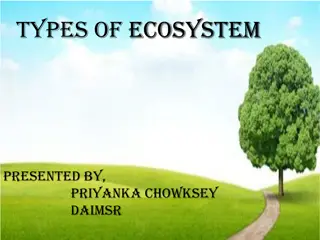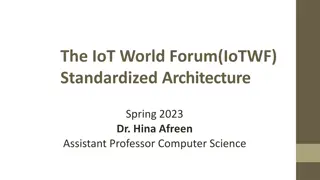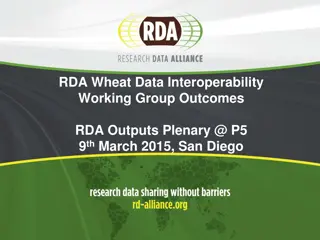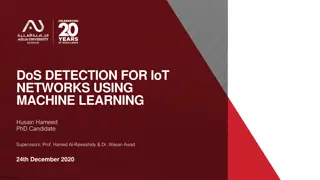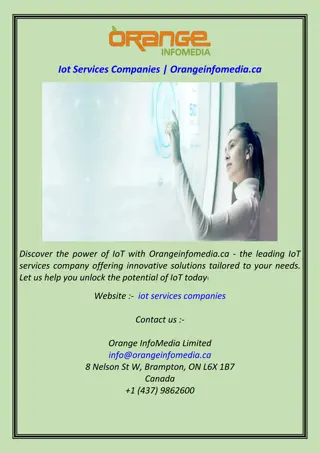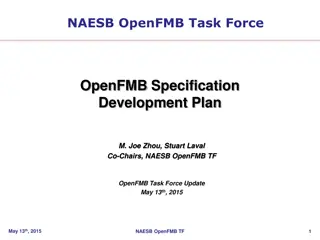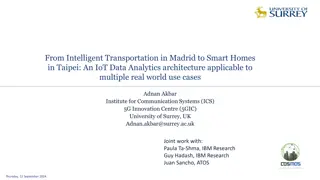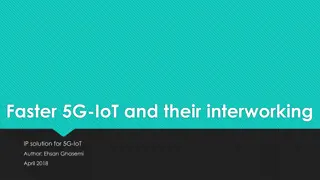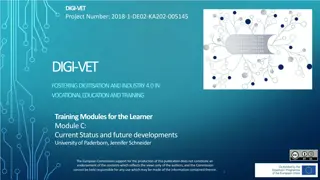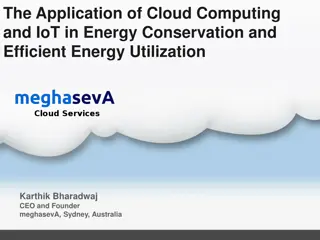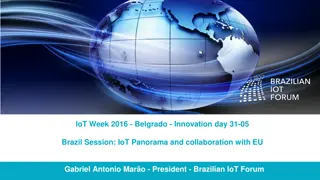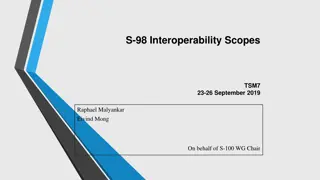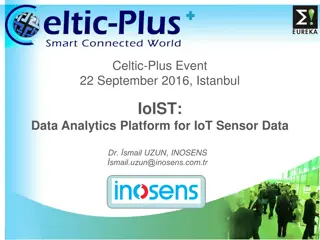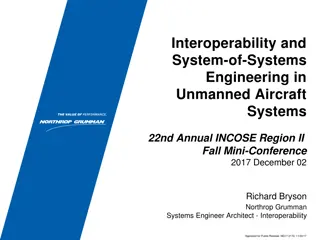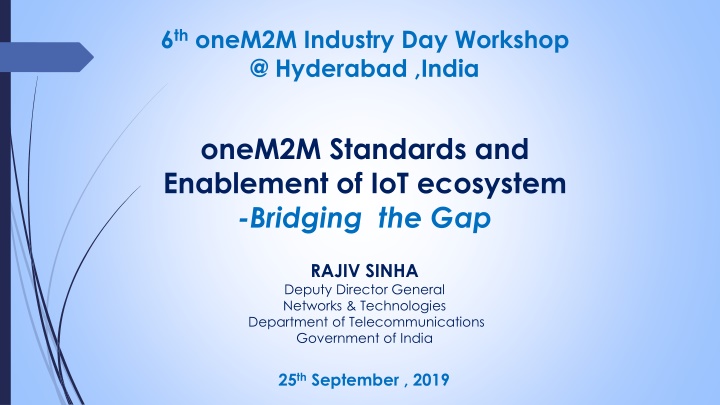
Bridging the Gap: Importance of IoT Ecosystem and Interoperability
IoT presents new business opportunities, but faces challenges in business model evolution, interoperability, and smart city deployments. Investment-friendly environments and legal clarity are crucial for IoT growth and scalability.
Download Presentation

Please find below an Image/Link to download the presentation.
The content on the website is provided AS IS for your information and personal use only. It may not be sold, licensed, or shared on other websites without obtaining consent from the author. If you encounter any issues during the download, it is possible that the publisher has removed the file from their server.
You are allowed to download the files provided on this website for personal or commercial use, subject to the condition that they are used lawfully. All files are the property of their respective owners.
The content on the website is provided AS IS for your information and personal use only. It may not be sold, licensed, or shared on other websites without obtaining consent from the author.
E N D
Presentation Transcript
6th oneM2M Industry Day Workshop @ Hyderabad ,India oneM2M Standards and Enablement of IoT ecosystem -Bridging the Gap RAJIV SINHA Deputy Director General Networks & Technologies Department of Telecommunications Government of India 25th September , 2019
Need for M2M/IoT ecosystem IoT is transformational IoT will generate significant socio-economic benefits to our society. It will enable innovation through the creation of new services, thereby enhancing the functionality of existing ones, and the smarter and more efficient use of resources. IoT presents new business opportunities for the MNOs, SMEs to reach more markets and customers. IoT enables large business to operate more efficiently, improve distribution and reduce costs
Issues for enablement of M2M/IoT ecosystem IoT will impact business model evolution The IoT value chain is complex and highly competitive IoT requires a technology and service neutral approach Investment-friendly environment is the need for the IoT to scale In the IoT world the customer relationship will become more contestable There is need to ensure consistency and clarity on legal, data protection and privacy regulation across verticals and jurisdictions.
Importance of Interoperability The Buenos Aires Declaration (WTDC-17) has recognised that widespread conformance telecommunication/ICT equipment and systems can: and interoperability of increase market opportunities Increase competitiveness and reliability encourage global integration and trade. The emphasis on importance of Interoperability as recognised by WTDC requires an environment for conformance and interoperability testing. The showcasing through demonstrations will facilitate and enable this requirement.
Roadblocks for Smart Deployments A combination of scale and complexity: Cities are large organisms Each city has different priorities and stakeholders to manage (The challenges of coordinating multiple stakeholders in a smart city ecosystem) Smart city solutions are hard to standardize The complexities of data management, owing in part to privacy regulations and the risk of security vulnerabilities The lack of deployment at scale of technological solutions. Despite plenty of pilot programs, and the individual proof of concept of some specific smart city applications, this combination of hurdles has kept most initiatives from moving beyond the initial phase, limiting the overall value captured.
Road blocks for Smart Deployments There are plenty of reasons for the small scale of smart city applications so far One is that limited-scale projects involve fewer stakeholders, making it easier to move fast and avoid the need for interoperable systems, an increasing issue as more participants are involved Investments are smaller and the business potential doesn t have to be fully clear at the start Technology scalability is usually not a concern, and capacity requirements are limited. The data management parameters are manageable as the number of inputs is small and security and privacy implications are limited.
Road blocks for Smart Deployments 1. Ecosystem A combined effort is required from an ecosystem of public and private stakeholders, which often have different agenda Smart city solutions are often complex and require a consortium of public and private partners to come together Need to work out such critical issues as the business case, policy considerations and technology hurdles A disconnect between smart cities solutions and existing city problems, together with a lack of technology expertise in government , can result in misguided efforts that do not effectively address citizens needs
Road blocks for Smart Deployments 2. Technology In some cases, technology cannot be deployed affordably at scale, since the required infrastructure ,in terms of latency and bandwidth, doesn t exist The existing network infrastructure cannot support the number of devices required Specific advanced smart city solutions may require new technologies, such as edge computing, to be scaled up.
Road blocks for Smart Deployments 3.VALUE CASE At scale, the investments are considerably larger, business cases are harder to demonstrate and intangible social or indirect benefits are not easily captured A large number of initiatives do not proceed beyond the pilot phase because indirect benefits cannot be monetized Private players cannot demonstrate a positive business case.
Road blocks for Smart Deployments 4. DATA MANAGEMENT Complexity and risk increase as more data sources are connected Privacy considerations and national and international regulations, along with the risk of negative press attention, can slow adoption Security considerations outweigh the benefits of solutions
Standardization and IoT deployments Need of Standardization: According to a recent study from Machina Research, an M2M and IoT research firm, cities worldwide could waste as much as $341bn by 2025 if they adopt a fragmented approach towards IoT as opposed to a standardised one This sum comes from the extra cost of vendor lock-in, lack of interoperability and higher system-integration fees Machina further points out that fragmentation of different IoT platforms will dampen the rollout of connected devices and could even curtail adoption of smart city apps
Standardization and IoT deployments oneM2M is a response to the growing demand for a smarter approach to smart cities Based on open standards, developed in partnership with its some 200 members worldwide, which standards bodies, oneM2M marks a seismic change in the IoT landscape. It combats market fragmentation include various regional Instead of the vertical approach, where cities might have several dedicated IoT platforms, one for smart metering, another for waste management and so on, oneM2M enables different IoT use cases to be supported by the same platform. The horizontal approach
Standardization and IoT deployments Interoperability of this sort, where different apps can use the same device management and security software, or where sensor- generated data is put to multiple uses, it can reap huge cost savings for city authorities In an era of globalisation, businesses pay close attention to these listings before deciding where to invest. By adopting oneM2M, however, cities have a route to much more cost-efficient IoT deployment, especially as apps and devices proliferate. There is also peace of mind. Legacy implementations, through the development of adapters, can be brought onto the oneM2M horizontal platform without disruption
Roadmap for Adoption of oneM2M Standards in India There is no denying of the fact that oneM2M standards are here to stay What next ? Demonstrate organizations/enterprises/city the oneM2M network architecture to the How? TSDSI should showcase its benefits to stakeholders across all verticals. Collaborative efforts are required. Government will extend all support
Roadmap for Adoption of oneM2M Standards in India Invite existing IoT solution/platform providers who are deploying oneM2M based solutions to demonstrate interoperability among oneM2M compliant solutions Organize it on zonal basis for wider participation Security of deployment is a concern: demonstrate that rogue devices and applications do not get access Also onboard proprietary solution providers/platform providers and educate them how to integrate with oneM2M platform This will boost their confidence(city planners & IoT platforms) that their investment are secured : A win- win situation for all stakeholders of value chain
Challenges for IoT deployments Ultimately, when things become interconnected and highly autonomous, entirely new business opportunities will emerge, creating an economy of things Privacy, Security and Ownership are the key issues which need to be taken care while enabling IoT ecosystem IoT devices must retain a certain amount of privacy when processing data and have security measures built in Ownership of data must also be established clearly for consumers to feel comfortable with integrating IoT into their daily lives
Challenges for IoT deployments The incredible connectivity that comes with the IoT has made it the ideal target for hackers Reason: a vast majority of the connected devices released in the market is deployed with little consideration for threat protection. Cyber security systems must be capable of intelligently monitoring and taking action in shutting down malware. They must be programmed to identify threat patterns, allow or deny network access and stop risks, all without human intervention. Updated Security Standards suited for requirements to IoT is the need of the hour.
Way Forward Recent reports by ASSOCHAM and EY reveal that the Indian IoT market has the potential to unlock USD $11.1 billion in revenues by 2022 by reaching 2 billion connections, making it a key economic contributor that will help propel India towards a USD $1 trillion economy The most successful IoT solutions will have the agility to expand and pivot in line with market trends and customer expectations. IoT offers the opportunity to enhance the capabilities of existing products by adding new features or tailoring them for new markets While IoT promises to connect all things people, devices and networks it is the integration of applications and data in the cloud that will truly propel its use and value making IoT cloud the new engine of growth for businesses, societies and nations
In Conclusion oneM2M standards adoption is essential for growth and enablement of IoT ecosystem in the country At present, lack of M2M standards seems to be a major roadblock for mass deployment of M2M services Lack of standardization is likely to halt the M2M juggernaut oneM2M standards will provide an impetus for mass scale deployment of IoT especially for those enterprises who at present are sitting on the fence to see which way the wind blows So, let us collaborate for bridging this gap for seamless connected society

